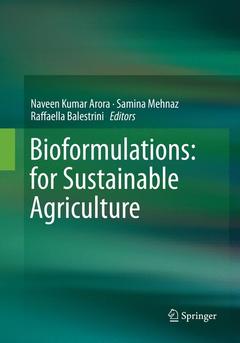Description
Bioformulations: for Sustainable Agriculture, Softcover reprint of the original 1st ed. 2016
Coordinators: Arora Naveen Kumar, Mehnaz Samina, Balestrini Raffaella
Language: English
Subject for Bioformulations: for Sustainable Agriculture:
Keywords
Biofertilizers; Bioformulation; Bioinoculants; Biopesticides; PGPR
Publication date: 06-2018
Support: Print on demand
Publication date: 06-2016
Support: Print on demand
Description
/li>Contents
/li>Biography
/li>Comment
/li>
More than a century has passed since the first bioformulations were introduced to the market. But there is still much to be done, explored and developed. Though bioformulations offer green alternatives and are important for sustainable agriculture, they make up only a small fraction of the total additions used to enhance crop yields or protect them from pests. There is a great need to develop bioformulations that can promote confidence among end users; accordingly, it is imperative that bioformulations to replace chemicals be reliable and overcome the shortcomings of the past.
Bioformulations: for Sustainable Agriculture discusses all the issues related to the current limitations and future development of bioformulations. It examines in detail those bioformulations that include biofertilizers and biopesticides (also commonly known as bioinoculants), presenting a global picture of their development. Further chapters address diverse microbes that are already being or could be used as bioformulations. The book also discusses the techniques, tools and other additions required to establish bioformulations as trustworthy and global solutions. It assesses the types of bioformulations currently available on the market, while also considering the future roles of bioformulations, including the reclamation of marginal and polluted soils. Further, it discusses the current legislation and much-needed amendments. Overall the book provides a comprehensive outlook on the status quo of bioformulations and the future approaches needed to improve them and achieve sustainable agriculture and food security without sacrificing the quality of soils. This will be extremely important in offering chemical-free foods and a better future for generations to come.
Part 1. Introduction.- 1. Bioformulations for Plant Growth Promotion and Combating Phytopathogens: A Sustainable Approach.- 2. Formulation Technology of Biocontrol Agents - Present Status and Future Prospects.- 3. Beneficial Microorganisms: Current Challenge to Increase Crop Performance.- 4. The Production and Potential of Biofertilizers to Improve Crop Yields.- 5. Effect of Bioinoculants on the Quality of Crops.- Part 2. Diverse Applications.- 6. The Biological Potential of Arbuscular Mycorrhizal Fungi.- 7. The Use of Arbuscular Mycorrhiza Fungi in Combination with Trichoderma spp. in Sustainable Agriculture.- 8. Bioformulations of Novel Indigenous Rhizobacterial Strains for Managing Soilborne Pathogens.- 9. Bio-Based and Reduced-Risk Strategies for the Management of Phytophthora Blight and Root Rot of Pepper.- 10. Formulation of Pochonia chlamydosporia for Plant and Nematode Management.- 11. Improvement of Crop Protection and Yield in Hostile Agroecological Conditions with PGPR–Based Biofertilizer Formulations.- 12. Use of Indigenous Cyanobacteria for Sustainable Improvement of Biogeochemical and Physical Fertility of Marginal Soils in Semiarid Tropics.- Part 3. Present Scenario and Future.-13. The Contribution of Secondary Metabolites in the Success of Bioformulations.- 14. Encapsulation Techniques for Plant Growth Promoting Rhizobacteria.- 15. An Overview of Globally Available Bio-Formulations.- 16. Regulation of Biopesticides: Global Concerns and Policies.
Dr Naveen Kumar Arora, PhD Microbiology, Associate Professor in Department of Environmental Microbiology, Babasaheb Bhimrao Ambedkar University (A Central University), Lucknow, Uttar Pradesh, India is a renowned researcher in the field of Environmental Microbiology and Biotechnology. His specific area of research is rhizosphere biology and PGPRs. He has 38 research papers published in premium international journals and several articles published in magazines and dailies. He is editor of the book ‘Plant Microbe Symbiosis: Fundamentals and Advances’, published by Springer. He is member of several national and international societies and reviewer of several international journals. He has delivered lectures in conferences and seminars around the globe. He has a long standing interest in teaching at the PG level and is involved in taking courses in bacteriology, microbial physiology environmental microbiology, agriculture microbiology and industrial microbiology. He has been advisor to 57 post graduate and 03 doctoral students. Recently he was awarded for excellence in research by the Honorable Governor of Uttar Pradesh. Although an academician and researcher by profession he has a huge obsession for the wildlife and its conservation and has authored a book, Splendid Wilds. He has a dedicated website www.naveenarora.co.in for the cause of wildlife and environment conservation.
Raffaella Balestrini, PhD in Biology and Biotechnology of Fungi, Senior Researcher at the Institute for Sustainable Plant Protection, CNR. Researches mainly focus on different aspects of plant-symbiotic fungi interactions (endo and ectomycorrhizae). Researches currently developed, using molecular and cellular approaches including confocal microscope, in situ hybridization and laser microdissection (LMD), are: genomics and functional genomics in mycorrhizal fungi; cellular and molecular interactions between plants and mycorrhizal fungi, with part
Provides an insight into the scenario of bioformulations around the globe and the ways to uplift them
Focuses on the constraints faced by the bioformulations (biofertilizers and biopesticides) and how they can be removed
Elaborates on the future and novel roles of bioformulations in reclamation of waste lands (rhizoremediation) and combating biotic and abiotic stresses posed due to anthropogenic activities and climate change
Describes how future formulations be designed and developed




